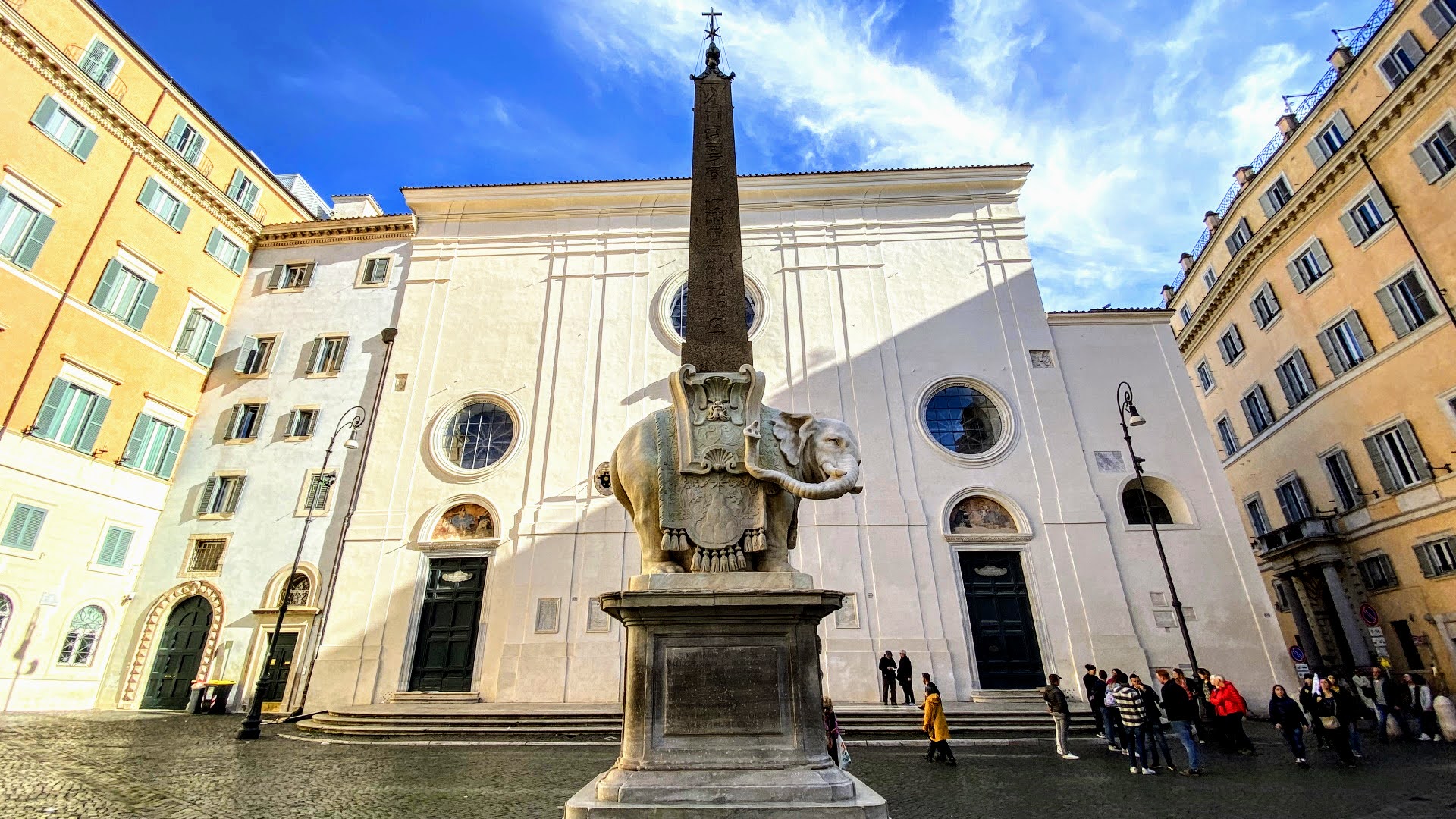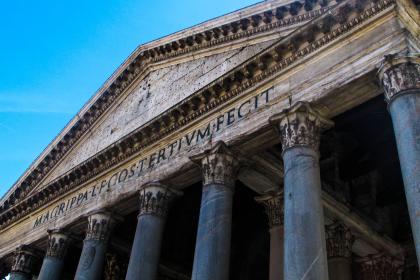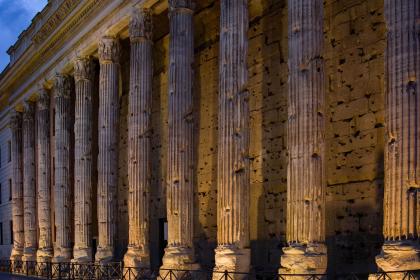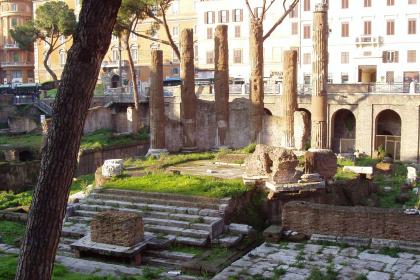
Der Obelisco della Minerva: die kuriose Geschichte eines steinernen Elefanten in der Mitte der bezaubernden Piazza della Minerva.
In der Mitte der bezaubernden Piazza della Minerva steht dieser kleine Obelisk aus rotem Granit aus dem 6. Jahrhundert v. Chr., der ursprünglich in der Nähe des Iseum Campense stand, dem Heiligtum, das Isis und ihrem Gatten Serapis auf dem Campus Martius gewidmet war.
Nach einem Sturz blieb der Obelisk bis 1665 im Boden verborgen, als er zufällig von einigen Dominikanermönchen bei den Bauarbeiten für das Fundament der Mauer, die den Garten der Basilika Santa Maria sopra Minerva umgibt, entdeckt wurde.
Der Obelisk ist nur etwa 5,5 Meter hoch, erreicht aber mit dem Kreuz und dem berühmten elefantenförmigen Sockel, der von Gian Lorenzo Bernini entworfen und 1667 von seinem Schüler Ercole Ferrata ausgeführt wurde, 12 Meter.
Der Obelisco della Minerva: die kuriose Geschichte eines steinernen Elefanten
„Und er ruft mit seinem Rüssel nach hinten: Dominikaner, hier steht ihr!“.
Mit dem berühmtesten kleinen Elefanten Roms lässt Bernini seine ganze Frustration in der kuriosen Geschichte zum Ausdruck kommen, die den Bau eines der von Römern und Touristen gleichermaßen geliebten Monumentalkomplexe begleitet.
Papst Alexander VII. Chigi beschloss, den Elefanten vor der Kirche der Dominikaner aufzustellen, und prüfte daher mehrere Vorschläge, um den geeignetsten Sockel für den Elefanten zu finden.
Einer der vorgelegten Entwürfe war der des Dominikanermönchs Domenico Paglia. Das Denkmal sollte auf sechs kleinen Hügeln ruhen, die an das Wappen der Familie Chigi erinnern sollten, aber das hätte zu selbstherrlich wirken können.
Der Papst wollte ein Werk, das eher an die Verherrlichung der göttlichen Weisheit erinnern sollte: „Alexander VII. weihte diesen antiken Obelisken, ein Denkmal der ägyptischen Athene, das ausgegraben und auf dem Platz aufgestellt wurde, der einst der Minerva und jetzt der Mutter Gottes geweiht war, im Jahr des Heils, 1667“.
Er entschied sich daher für den Entwurf von Gian Lorenzo Bernini, dem größten Architekten und Bildhauer des römischen Barock, der eine Statue in Form eines Elefanten vorschlug. Das Tier sollte Stärke symbolisieren, woran auch die Inschrift auf dem Sockel erinnert, die lautet: „Wer die eingemeißelten Bilder der ägyptischen Weisheit auf dem Obelisken betrachtet, der vom Elefanten, dem stärksten aller Tiere, getragen wird, erkennt, dass es eines starken Geistes bedarf, um eine solide Weisheit zu tragen.
Neid in Form eines kleinen Elefanten: das Geheimnis von Bernini und dem Obelisken
Die Dominikaner, die über die Wahl des Papstes verärgert waren, kritisierten Bernini offen. Ihrer Meinung nach wäre der von ihm entworfene kleine Elefant unter dem Gewicht des riesigen Obelisken zusammengebrochen, da er keine zentrale Stütze hatte. Der Künstler wehrte sich hartnäckig gegen den Einbau eines Elements, das die Ästhetik der Komposition zerstört hätte, musste aber schließlich dem Drängen des Papstes nachgeben. Die Füllung wurde unter dem Bauch des Elefanten angebracht, musste aber getarnt werden. Bernini schuf daraufhin eine sehr aufwendige Kopfbedeckung, die jedoch die Silhouette des Dickhäuters erheblich beschwerte und ihn gedrungen und unbeholfen erscheinen ließ.
Berninis unverschämter Gruß: wenn sich die Kunst rächt
Aus Rache für die Einmischung der Dominikaner, die sein Projekt ruiniert hatten, richtete Bernini das voluminöse Hinterteil des Tieres in Richtung ihres Klosters. Mit seinem leicht zur Seite geneigten Schwanz und der Rückwärtsbewegung seines Rüssels grüßt der kleine Elefant seither frech die Ordensbrüder.
Der Obelisk wurde am 11. Juli 1667 der Öffentlichkeit vorgestellt, aber Papst Alexander VII. konnte der Zeremonie nicht beiwohnen, da er am 22. Mai starb.
Das Küken der Minerva: ein Spitzname, der die Zeit überdauert
Schon bald wurde das Monument Opfer des bissigen Humors der Römer, die es wegen seiner gedrungenen, ferkelähnlichen Gestalt liebevoll „Porcino della Minerva“ „Minervas Schweinchen“, nannten.
Im Laufe der Zeit wandelte sich der niedliche Spitzname in den Ausdruck „Purcino“ um, eine römische Dialektform für „Küken“, und so entstand „Pulcino della Minerva“, der Name, unter dem er noch heute bekannt ist.
Schätze in der Nähe, die Sie nicht verpassen sollten
Nach dem aufregenden Besuch dieses herrlichen Beispiels barocker Genialität sollten Sie nicht vergessen, dass Sie sich im Herzen des historischen Zentrums von Rom befinden und somit die Qual der Wahl haben. Sie können Ihren Spaziergang mit dem Pantheon und seiner tausendjährigen Geschichte oder mit der Basilika Sant’Eustachio fortsetzen, die von dem charakteristischen Hirschkopf gekrönt wird.
Zu den Sehenswürdigkeiten gehören:
- der Heilige Bezirk von Largo Argentina,
- die Kirche San Luigi dei Francesi, in der sich drei Gemälde von Caravaggio befinden,
- der Tempel von Vibia Sabina und Hadrian,
- oder, wenn Sie in die außergewöhnliche Schönheit der Kunstwerke eintauchen wollen, die Galerie Doria Pamphilj.
Foto: Redaktion Turismo Roma
Das Pantheon

 Condividi
Condividi
Tempio di Vibia Sabina e Adriano

 Condividi
Condividi
Area Sacra di Largo di Torre Argentina - Der Heilige Bezirk von Largo di Torre Argentina

 Condividi
Condividi
Informationen
 Condividi
Condividi
Location
Um mehr über alle barrierefreien Dienste zu erfahren, besuchen Sie den Abschnitt barrierefreies Rom.











































